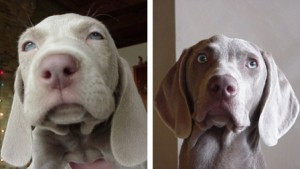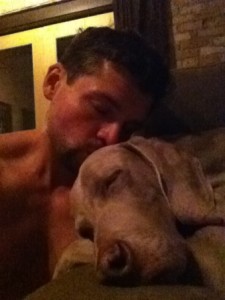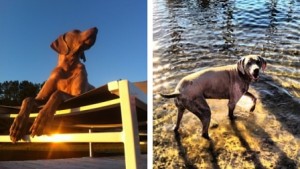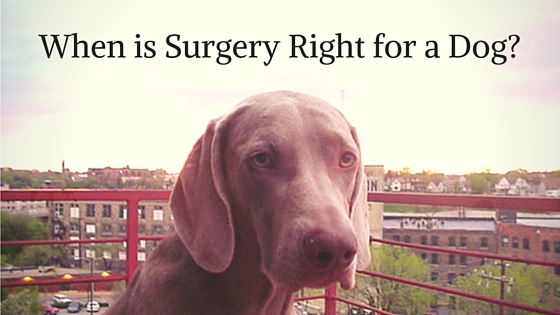Our pets are family. They bring enormous joy and unconditional love to our lives. In turn, we provide them with the happiest, most comfortable life possible. That’s our responsibility.
Caring for our pets isn’t always easy. We rely on veterinarians if unexpected conditions merge. If surgery becomes an option, our vets lay out the risks and reasonably expected outcomes.
With no guarantees, it often boils down to this: do what you think is best for your best friend. When risk is your best option, proceed with caution.
We considered surgery before. Our first dog had a brain tumor which caused him to have seizures. Now, our second dog has a tumor on his chest that won’t stop growing. It’s as big as half a basketball.
Here are their stories.

Meet the pups – In July 1999, Denver entered and forever changed our lives. His favorite thing to do was bring back whatever you threw, unless it was edible.
In December 2001, we called the same breeder to ask about a future litter. She said a litter arrived seven weeks earlier and the puppies were available now. Same parents.
We lived in Milwaukee at the time. A Wisconsin winter in a building with the slowest elevator known to man isn’t optimal for potty training. It was too cold and too quick. We decided against it.
Two days later, the phone rang. It was the breeder. Denver’s mom was hit by a car and died. This was the last litter. We picked Marco up the next day.

Denver was the athlete and Marco was the puppy. Denver fetched while Marco walked around. Denver fearlessly swam; Marco waited on shore. For 10 years, Marco followed Denver everywhere.
Something’s wrong with Denver – In 2009, Denver began waking up at night. He would sit upright, slightly twitch, and then go back to sleep. The episodes were short and subtle, but not unnoticed.
Within a few weeks, he had his first grand mal seizure.
Seeing a dog have a seizure is scary and heartbreaking. Once the seizure starts, all you can do is make sure they aren’t knocking into walls or furniture until it’s over. You feel helpless.
Our vet told us that Denver’s seizures were likely due to a brain tumor. Of course, we had a million questions. Naturally, we asked about removal. How common was this? Was she sure it was a brain tumor? Is he going to die?

There was a lot to learn, but treatment can go two ways: medication or removal.
She prescribed phenobarbital in an effort to prevent the seizures while we discussed surgery. Within weeks, he had another seizure. More followed. The phenobarbital wasn’t working by itself.
The seizures I witnessed always occurred after midnight. He fell off the bed and hit the floor, convulsing violently. His eyes stayed open with a blank stare while chomping his jaw and foaming at the mouth. Sometimes he peed.
The seizures lasted about a minute. Then he laid still, breathing quickly, with his tongue out. He wouldn’t respond to touch or voice. He would only blink when he began to regain consciousness.
We returned to the vet and told her we wanted an MRI, which was the next step to move forward with surgery.
Meanwhile, prednisone was added to his daily cocktail.
Denver was 10 when the MRI confirmed what we were already told. Now, we knew the size and position of the tumor. They estimated that he had about six months to live if the tumor kept growing. The meds were an attempt to combat swelling and growth.
We scheduled an appointment with the surgeon, but we couldn’t get in immediately. During the next couple weeks, Denver responded positively to the prednisone. Experiencing fewer seizures helped change our conversation.
No surgery for Denver – Emotions are hard, if not impossible, to separate when making difficult decisions concerning your pet.
We determined the surgery was too invasive. He was too old. As it were, he had six months left whereas he might not survive the procedure. The prednisone worked well enough to get us away from the ledge.
Six months passed. By then, Denver’s seizures were often a month apart. We adjusted his meds, as needed, over the next year.
By spring 2011, 18 months after his diagnosis, the side effects of prednisone couldn’t be ignored. His attitude changed. He began peeing inside regularly. He was always thirsty and his hunger was endless.
He ate tissues and toilet paper at every opportunity. We’d find rolls of toilet paper that looked like apple cores. He ripped the dispensers out of the drywall in both bathrooms. He destroyed other things looking for food.
Who was this dog? He wasn’t the same. He looked uncomfortable and scared, almost as if he weren’t in control.
We decided to wean him off prednisone.
Although his attitude improved, the seizures returned. They became more frequent and worse. His recovery was longer. After regaining consciousness, he had a new phase that lasted up to 30 minutes. He couldn’t hear and I’m not convinced he could see. He was turbo charged and ran into walls and got tangled up in cords. He broke things.
I remember grabbing his head and staring into his eyes and yelling, “Denver, Denver, Denver!” trying to get some type of response from his vacant eyes.
Nothing.
I let him go and he’d roam room to room as I listened to him bump into walls and knock things over at 3:30 a.m. It was clear that we had yet to make the hardest decision.

Farewell, old friend – Denver had really good days, but he was on his way down. Our vet knew Denver his entire life. She assured us it was okay to let him go on a high note. We scheduled his euthanasia for five days later.
During his last days, my ex moved back in and we celebrated Denver’s life. We did all the things Denver loved. He ate like a king. The morning of the appointment, he acted like any other day the past 12 years. It was hard to not change our mind.
He was 12. He never had another seizure. He is in a better place. August 31 will always be Denver Day.

Marco solo – Marco mourned for two weeks following Denver’s passing. Life, as he knew it, always included Denver.
Marco turned 10 that year. Although he never developed a brain tumor, he began developing a different tumor. It’s become a problem.
The tumor – The fatty tumor started growing between Marco’s chest and left front leg shortly after Denver’s passing. It looked like a single breast implant. By the time we moved to Arizona in 2013, it had grown to the size of a grapefruit. Marco was 12.
At that time, the aesthetic of the tumor was its worst quality. It didn’t affect his movement or mobility. Surgery seemed like a stupid risk, especially at his age. The question became, how much and how fast will it grow?
Honestly, I don’t think we expected Marco to last a year in Arizona.
Today, however, I’m pleased to report that Marco is healthy. He’s full of energy and still acts like a puppy. He will be 14 next month.
The tumor, however, continues to grow. It has more than doubled in size. Marco’s limping more. It’s bulky. He looks so uncomfortable carrying it.
Even strangers are taken aback at its size. Their greetings have gone from “Oh, what’s that?” to “Whoa! That’s huge!” Now, they express sympathy.
What would Joan Rivers do? – I’m kidding, we all know what she would do. Joking aside, that’s exactly why I’m scared. The other day, for the first time, the vet said we should have the surgery.
The procedure sounds straightforward. The biggest problem is the location of the wound. Recovery will be a little more difficult.
Is surgery worth the risk at 14? Will that give Marco the happiest, most comfortable life? 14 is old for a Weimaraner. The tumor will continue to grow. Which option doesn’t shorten his life? I wish I knew.
We have an appointment scheduled for another opinion. I’ll let you know what happens.
UPDATE: The second opinion was with the surgeon who would perform the procedure. Marco’s in great health. He’s scheduled to undergo testing on Halloween – in two days. He’s taking his Frankenstein costume seriously this year. Pending successful tests, he will have the tumor removed that day. Stay tuned.
 Copyright secured by Digiprove © 2015
Copyright secured by Digiprove © 2015 
